Back to Don's Maps
The Sacred Root
The sacred root is not Datura, however there is reason for thinking that Jean used at least the physical form and growth habits of mandrake when she created her "sacred root".
My thanks to Toos Spee for drawing this to my attention.
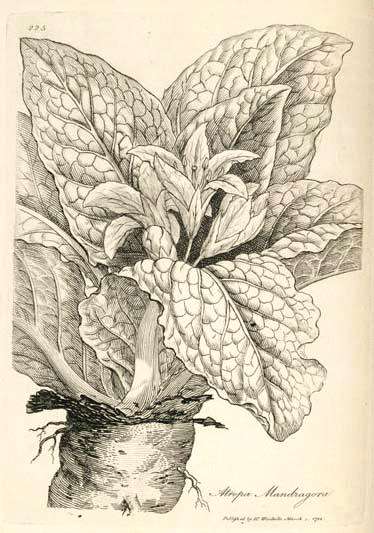
The name Mandragora is derived from two Greek words implying 'hurtful to cattle. ' The Arabs call it 'Satan's apple.'
It has a large, brown root, somewhat like a parsnip, running 3 or 4 feet deep into the ground, sometimes single and sometimes divided into two or three branches. Immediately from the crown of the root arise several large, dark-green leaves, which at first stand erect, but when grown to full size a foot or more in length and 4 or 5 inches in width - spread open and lie upon the ground. They are sharp pointed at the apex and of a foetid odour. From among these leaves spring the flowers, each on a separate foot-stalk, 3 or 4 inches high. They are somewhat of the shape and size of a primrose, the corolla bell-shaped, cut into five spreading segments, of a whitish colour, somewhat tinged with purple. They are succeeded by a smooth, round fruit, about as large as a small apple, of a deep yellow colour when ripe, full of pulp and with a strong, apple-like scent.
The leaves are quite harmless and cooling, and have been used for ointments and other external application. Boiled in milk and used as a poultice, they were employed by Boerhaave as an application to indolent ulcers.
The fresh root operates very powerfully as an emetic and purgative. The dried bark of the root was used also as a rough emetic.
Mandrake was much used by the Ancients, who considered it an anodyne and soporific. In large doses it is said to excite delirium and madness. They used it for procuring rest and sleep in continued pain, also in melancholy, convulsions, rheumatic pains and scrofulous tumours. They mostly employed the bark of the root, either expressing the juice or infusing it in wine or water. The root finely scraped into a pulp and mixed with brandy was said to be efficacious in chronic rheumatism.
Mandrake was used in Pliny's days as an anaesthetic for operations, a piece of the root being given to the patient to chew before undergoing the operation. In small doses it was employed by the Ancients in maniacal cases.
A tincture is used in homoeopathy to-day, made from the fresh plant.
Among the old Anglo-Saxon herbals both Mandrake and periwinkle are endowed with mysterious powers against demoniacal possession.
There are many allusions to the Mandrake in ancient writers. From the earliest times a notion prevailed in the East that the Mandrake will remove sterility, and there is a reference to this belief in Genesis 30:14. :
30:14. And Ruben going out in the time of the wheat harvest into the field, found mandrakes: which he brought to his mother Lia. And Rachel said: Give me part of thy son's mandrakes.
30:15. She answered: Dost thou think it a small matter, that thou hast taken my husband from me, unless thou take also my son's mandrakes? Rachel said: He shall sleep with thee this night, for thy son's mandrakes.
30:16. And when Jacob returned at even from the field, Lia went out to meet him, and said: Thou shalt come in unto me, because I have hired thee for my son's mandrakes. And he slept with her that night.
30:17. And God heard her prayers; and she conceived: and bore a fifth son:
30:18. And said: God hath given me a reward, because I gave my handmaid to my husband. And she called his name Issachar.
Photo and text from: http://www.botanical.com/botanical/mgmh/m/mandra10.html
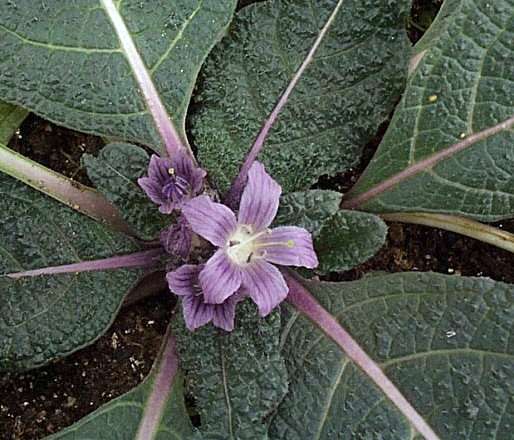
Image of Mandrake above from: http://www.plantoftheweek.org/week080.shtml
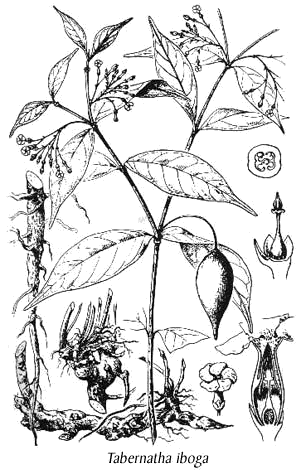
My thanks to Toos Spee for drawing this to my attention.


Image of Mandrake above from: http://www.plantoftheweek.org/week080.shtml

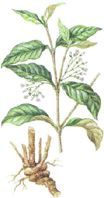
The following was posted on the Jean Auel Message Board on 30 September 1999 by Vaughn:
Use of Datura is mentioned (by name) several times in all four books ... the "sacred root" is different. I had wondered for years what it could be, but have only now, after years of study of all sorts of psychoactive chemicals, concluded that it has to be the powerful hallucinogen, ibogaine. Not only is ibogaine extracted from a root in the area in which Ayla's story takes place, but the accounts of her experiences with the substance match many trip reports I have read recently by a variety of psychonauts.
Edit: so far as I am aware, there is no root containing ibogaine in either Northern Iraq where the original cave is, nor in the Crimean peninsula where Jean placed the story.
Here is an exerpt from the Ibogaine entry in Alexander Shulgin's fascinating second book _TIHKAL_:
... There is a well studied history of the use of the iboga plant in the religious rituals in Gabon and its neighboring countries, from the early part of the 19th century. The Buiti religion calls for the use of the root bark of Tabernanthe iboga as a sacrament in its religion, and the reports of its psychopharmacological effectiveness reflects these needs (see Samorini). Another area of reports that can be called upon reflect the exploration of the isolate from this plant, or the isolated active component ibogaine itself, in the study of its use in connection with psychotherapy. Here the reports reflect the physician/patient interaction with an emphasis on early memory and the reliving of past experiences (see Naranjo). In clinical studies such as these, a typical dose would be four hundred milligrams of the chemical, twice this weight of the crude isolate, and perhaps ten times again this weight again if the actual root bark is used.
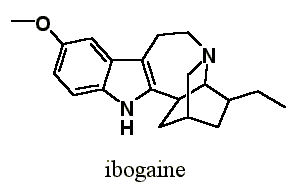
Yet another source of reports is to be found in some studies that are exploring ibogaine as a treatment for heroin dependency (see De Rienzo and Beal). This end-goal of searching for evidence of addiction confrontation and addiction control certainly can color any published reports in its own way. Here, its the chemical ibogaine only that is used, and typical dosages are at or above 1000 milligrams.
There is no question but that ibogaine is a rough trip, physically as well as mentally. Here is one report that shows the body aspects of its use.
(with 200 mg, orally) "Subjectively, the most unpleasant symptoms were the anxiety, the extreme apprehension, and the unfamiliar mood associated with visual and bodily hallucinations. The visual hallucinations appeared only in the dark and consisted of blue disks dancing up and down the walls. Dysesthesia of the extremities, a feeling of light-weightedness, and hyperacusis were other symptoms noted. Autonomic signs, such as dryness of the mouth, increased perspiration, slight pupillary dilation, and increase in pulse rate, as well as extrapyramidal syndromes (fine tremors, slight ataxia, enhanced tendon reflexes and clonus) were also present. The peak effect was reached at about 2 hours after swallowing the drug; it subsided gradually, leaving as a residue complete insomnia. No undesirable after-effects, such as exhaustion or depression occurred."
As was pointed out in a pharmacological review (see Popik et al.), as the hallucinogenic dose appears to be several times higher than the stimulant dose, the user must endure intense and unpleasant central stimulation in order to experience the hallucinogenic effects. But as fascinating as the pharmacology of ibogaine, it is the chemistry of this alkaloid that is overwhelmingly awesome. The presence of four isomers was mentioned in the chemistry section above, but this fact was not appreciated until the 1960's and even then, a coupe of troublesome errors were made that confused the absolute configuration picture quite badly. The story has been accurately told in a (almost) hundred page review chapter (see Cordell) which is a "must" for anyone who wants to risk understanding some pretty far out chemistry. Oh my, there are a lot of closely related alkaloids. As to indolic alkaloids in general, there are well over two thousand of them, with a few dozen being added every year. And most of these are kosher tryptamines in that they carry the tryptamine structural skeleton. And, in turn, a great number of the tryptamine alkaloids are found in the remarkable family Apocynaceae, which is the ultimate treasure-trove of alkaloids, probably the richest single source of pharmacologically active compounds in the entire plant kingdom. It is made up, largely, of tropical shrubs of the dog bane group, which almost always ooze out a sticky sap when you break off a twig, which have showy flowers, and which have the reputation of being very poisonous.
And this all leads smoothly to the botany, which is almost as convoluted as the chemistry. Here, let me list the plants that contain ibogaine, or that should contain it. Allow me a brief run-down of binomials. There is a number of species that are, or have been, classified as belonging to the Tabernanthe genus and which are reasonable sources of ibogaine, and which are logical alternatives, psychopharmacologically, to the iboga plant itself.
Tabernanthe iboga. This is the major source of ibogaine and is found in Gabon, mentioned above. Tabernanthe orientalis. This plant is now called Ervatamia orientalis, and is found in Western Australia. The leaves contain ibogaine, along with six minor alkaloids that are closely related, structurally.
Tabernanthe pubescens. This is found in Zaire, and contains a number of alkaloids closely related to ibogaine in structure, as well as ibogaine itself.
Tabernaemontana spp. This genus is from a tribe within the family Apocynaceae that is called the Tabernaemontaneae. As an official sub-family it would be called Tabernaemontanoideae. It is because of the casual use of names such as these that botanical binomialists are rarely invited to social functions. It (this Genus, that is) contains several dozen species, some with ibogaine, many with analgesic or sedative action in experimental animals, and some with a quite a history of native usage either in Africa or Southeast Asia.
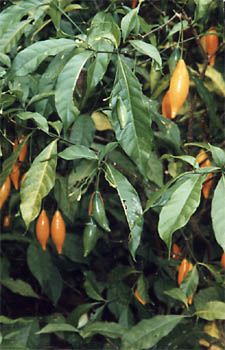
From: http://www.ibogaine.org/bwiti1.html
Abstract
Tabernanthe iboga H.Bn. is an apocynaceous shrub from Equatorial Africa whose roots are used in Gabon at low doses as a stimulant and at high doses during the ceremony for admission into the Gabonese initiation society, the Bwiti.
Four periods are described:
the first three relate to the pharmacodynamic studies conducted in France (1864-1905; and 1940-1950) and subsequently in the U.S.A., essentially Ciba's work (1950-1970).
The low acute and chronic toxicity of ibogaine is established (Dhahir, 1971).
Ibogaine inhibits the oxidation of serotonin and catalyzes that of catecholamines by a MAO (monoamine oxidase), ceruloplasmin (Barrass and Coult, 1972). Ibogaine is a type of hallucinogen (oneirophrenic) at high doses.
The present period began around 1960 and covers the applications of ibogaine in psychotherapy and psychoanalysis according to Naranjo (1960) and in combatting drug dependency according to Howard S. Lotsof.
The role of iboga in Bwiti initiation ceremonies was studied by ethnologists in Gabon.
The intoxication by iboga (chewing) is slow and progressive and is characterized by four stages of oneiric manifestations.
The first three stages are essentially of the Freudian type; the fourth one, called the stage of normative visions, corresponds to the collective image of the tribe, visions of the beyond and of spiritual entities, Masters of the Universe.
The initiate will see the Bwiti only twice during his life, on the day of his initiation and on the day of his death, which means that the normative visions have some similarities to the near death experience (NDE).
The psychotherapeutic method of Naranjo involves only the Freudian stages produced by subtoxic doses of ibogaine, while H.S. Lotsof goes beyond that stage to reach another one comparable to the normative visions or NDE, bringing about the cure of addicts.
Based on recent "neuroscientific" evidence concerning the mode of action of ibogaine, the National Institute on Drug Abuse (NIDA) has added ibogaine to the list of drugs whose activity in the treatment of drug dependency is to be evaluated. Ibogaine blocks the morphine- and cocaine-induced stimulation of mesolimbic and striatal dopamine and reduces the intravenous self-administration of morphine in rats.
Pharmocodynamics and therapeutic applications of iboga and ibogaine.
From:
http://www.shaman-australis.com/Website/Tabernantheiboga.htm
Botanical information
An evergreen shrub, it grows to a height of 1.2m with a spread of 1.5m. The stem is erect and branching; the leaves are dark green, opposite and narrowly ovate-acuminate; the flowers are white to yellowish and widely expanding tubular. A native of Gabon (Africa), it prefers well composted, well drained soils in a protected partky shady position, and is drought and frost tender.
Propagation is by fresh seed or by cuttings.
Sow seed 1cm deep in moist but well-drained seedmix and keep warm. Should germinate within a few weeks, but may take several months. Transplant into single pots when 10cm tall. (In older seed, the sprout has difficulties emerging from the hardened seedcoat. Careful removal of the seedcoat with a scalpel after the seed has swelled up and partially opened can increase the number of surviving seedlings considerably.)
From: http://www.ibogaine.co.uk/iboga-tourism.htm
The Bwiti are a Central African religious group whose usage of Tabernanthe iboga, the plant source of ibogaine, forms an integral part of their society. The rootbark of the Tabernanthe iboga plant contains approximately 12 different iboga alkaloids of which ibogaine is only one.
The word 'Bwiti' refers both to the religion - 'the Bwiti religion', and the group that practice it - 'the Bwiti'. There are estimated to be approximately 2-3 million members of the Bwiti religion scattered in groups throughout the countries of the Gabon, Zaire, and the Cameroun. Most are from the two principal tribal groups of the region, the Fang and the Mitsogho. The origins of the religion are obscure, but most writers seem to believe Bwiti is essentially derived from pygmy religious traditions which have been modified and adapted to suit local tribal tastes. Bwiti has thus become a highly synchretic religion, drawing from a multitude of sources, and interpreted slightly differently by each group that practice it.
The rootbark of the Tabernanthe iboga plant is usually referred to as 'iboga' or 'eboka' and it has two principal uses within the group. Firstly, small doses are used as a stimulant, principally when hunting and as an aid to ritual work. And, secondly, a much larger dose features as a central element of the 'Bwiti initiation ritual' - a powerful 'rebirth' ceremony that group members typically undergo before the commencement of their teenage years, and is a requirement for group membership. Both sexes are initiated and the ceremony typically lasts three days, beginning on a Thursday afternoon and ending Sunday morning.
Iboga is eaten on the first night of the initiation ceremony and may be further consumed on subsequent nights should it be deemed necessary. The consumption of iboga is supervised by the 'nganga', a senior priest of the religion whose knowledge of iboga's effects on the body and mind is such that he or she is aware of when the initiate has had sufficient. The overall objective of the ritual is to allow the initiate to enter deeply into the subconscious mind with the intent of emerging 'reborn'. In the depths of this inner realm, he or she is expected to actually 'meet' the original Bwiti, the founders of the religion, in the form of primordial male and female figures. But this can only be achieved once mighty terrors that lurk before them have been overcome.
This 'inner journey' is analogous to that undertaken by many 'hero' figures in classical mythology. And, in more Western terminology, it might be said that the usage of large doses of iboga here is intended to remove the effects of accumulated trauma or conditioning on the system. And further facilitate access to archetypal figures located within the Jungian concept of the 'collective unconscious'.
Once initiation is completed, the person becomes a full member of the Bwiti religion. And the act of having confronted the fears of those who went before means the individual may now be regarded as an adult.
From:
http://www.indra.dk/ukversion/ukindex.htm
*Dry, standardised extract of Tabernanthe iboga rootbark. 5 x extract, i.e. 1 gram of extract corresponds to 5 grams of dried root bark. The alkaloid profile is true to the original plant material.
Iboga roots have traditionally been used as a spiritual entheogen in Western Africa, where it is used in religious cults and rituals. One of its special qualities is the opening of ancestral memories and many people have reevaluated their entire line of experiences in this life. In smaller doses the iboga rootbark functions as a stimulant and aphrodisiac.
Ibogaine, the main alkaloid in the root bark is receiving considerable attention in medical and biological research. One of the main reasons is the possible practical application of ibogaine in the treatment of drug addictions (heroin, cocaine and alcohol). This seems to be partly due to the ability of ibogaine to make changes in the chemistry of the brain synapses. These changes can directly eliminate or reduce dependency to addictive substances. However, psychotherapy may also be necessary in connection to the ibogaine sessions to effectively break drug dependency.
From:
http://www.ibogaine.desk.nl/alkaloids.html
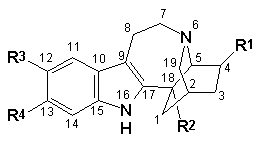
Figure 1.
| Compound | R1 | R2 | R3 | R4 |
| Ibogaine | CH2CH3 | H | OCH3 | H |
| O-Desmethylibogaine | CH2CH3 | H | OH | H |
| ( )-Ibogamine | CH2CH3 | H | H | H |
| ( )-Coronaridine | CH2CH3 | CO2CH3 | H | H |
| Tabernanthine | CH2CH3 | H | H | OCH3 |
| O-t-Butyl-O-Desmethylibogaine | CH2CH3 | H | OC(CH3)3 | H |
From a reply to a post:
-------Do you know what the plant in West Australia is called thats leaves contains this chemical? ---------
Tabernanthe orientalis, also called Tabernaemontana orientalis. This plant is now called Ervatamia orientalis, and is found in Western Australia. The leaves contain ibogaine, along with six minor alkaloids that are closely related, structurally.
see the links below.
From:
http://www.shaman-australis.com/Website/Tabernae-orientalis.htm
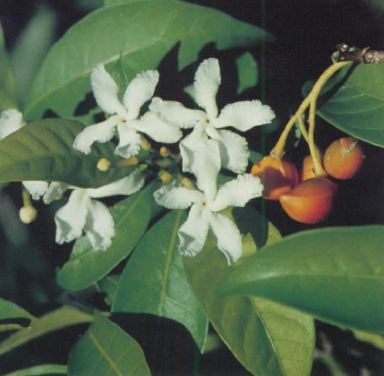
Australian Ibogaine Bush, Iodine Bush
Tabernaemontana orientalis (syn Ervatamia orientalis)
Australian Ibogaine Bush, Iodine Bush
Botanical information
An evergreen shrub, it grows to a height of 2.5m with a spread of 2m. The stem is erect and branching; the leaves are opposite, thick, smooth, 10-15cm long and narowly ovate-acuminate; the flowers are white, and expanding tubular. A native of Australia, India and some areas of the Pacific....
Traditional uses
The common name 'iodine bush' arose from its reputed use by Aborigines to cure sores and ulcers. It belongs to a family with many toxic members and this one has been suspected of poisoning horses and cows. However, there is no record of human poisoning and it appears that the protein-breaking enzymes, and possibly even antibiotics, in the milky latex may actually have healing properties. It has also been called Bitter Bark and has found use as a quinine substitute in colonial times. This Tabernaemontana is a close relative of the Tabernanthe iboga bush, which is used ritually in Africa.
From:
http://users.lycaeum.org/~mulga/iboga/knox.htm
Alkaloids of Ervatamia orientalis
Knox & Slobbe
Aust J Chem #28: 1813-56, 1975.
In this study leaves and bark of different Australian specimens were quantitavely and qualitatively analysed for their alkaloids. In the leaves the alkaloids isolated,at about 0.22% yield, were ibogaine, iboxygaine, ervatamine, 19-dehydroervatamine and apparacine. in the ratios of 1.8 : 0.25 : 0.5 : 1 : 2 respectively.
Three samples of bark were found to contain 1.3 %, 2 % and 1.4 % alkaloids. The alkaloids were found to be a mixture of ervatamine, tabernaemontanine, 16-demethoxycarbonyl-20-epidihydro-voacamine, 20-epiervatamine, dregamine, 19-dehydroervatamine, vobasine, voacamine, 16-demethoxycarbonyl-dihydro-voacamine and voacristine.
The following alkaloids are of the ibogan type, ibogaine, iboxygaine and voacristine.
The alkaloids voacamine, 16-decarbomethoxy-19,20-dihydrovoacamine and 16 decarbomethoxy-19,20-dihydro-20-epi-voacamine are actually dimeric alkaloids constructed from a single ibogaine molecule combined with either a dregamine or tabernaemontanine molecule.